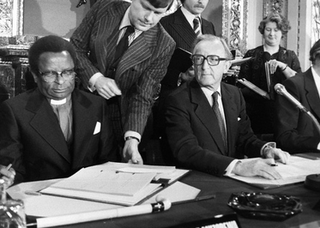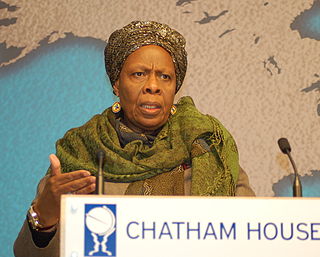Until roughly 2,000 years ago, what would become Zimbabwe was populated by ancestors of the San people. Bantu inhabitants of the region arrived and developed ceramic production in the area. A series of trading empires emerged, including the Kingdom of Mapungubwe and Kingdom of Zimbabwe. In the 1880s, the British South Africa Company began its activities in the region, leading to the colonial era in Southern Rhodesia.

Rhodesia, officially from 1970 the Republic of Rhodesia, was an unrecognised state in Southern Africa from 1965 to 1979, equivalent in territory to modern Zimbabwe. Rhodesia was the de facto successor state to the British colony of Southern Rhodesia, which had been self-governing since achieving responsible government in 1923. A landlocked nation, Rhodesia was bordered by South Africa to the south, Bechuanaland to the southwest, Zambia to the northwest, and Mozambique to the east. From 1965 to 1979, Rhodesia was one of two independent states on the African continent governed by a white minority of European descent and culture, the other being South Africa.

Zimbabwe, officially the Republic of Zimbabwe, is a landlocked country in Southern Africa, between the Zambezi and Limpopo Rivers, bordered by South Africa to the south, Botswana to the south-west, Zambia to the north, and Mozambique to the east. The capital and largest city is Harare. The second largest city is Bulawayo. A country of roughly 15 million people, Zimbabwe has 16 official languages, with English, Shona, and Ndebele the most common. Beginning in the 9th century, during its late Iron Age, the Bantu people built the city-state of Great Zimbabwe; the city-state became one of the major African trade centres by the 11th century, controlling the gold, ivory and copper trades with the Swahili coast, which were connected to Arab and Indian states. By the mid 15th century, the city-state had been abandoned. From there, the Kingdom of Zimbabwe was established, followed by the Rozvi and Mutapa empires.

Zimbabwe maintains relations with various countries around the world, and maintains close diplomatic relations with neighboring nations.

Ian Douglas Smith was a Rhodesian politician, farmer, and fighter pilot who served as Prime Minister of Rhodesia from 1964 to 1979. He was the country's first premier not born abroad, and led the predominantly white government that unilaterally declared independence from the United Kingdom in November 1965 following prolonged dispute over the terms, particularly British demands for black majority rule. He remained Prime Minister for almost all of the 14 years of international isolation that followed, and oversaw Rhodesia's security forces during most of the Bush War, which pitted the unrecognised white administration against communist-backed black nationalist guerrilla movements. Smith, who has been described as personifying white Rhodesia, remains a highly controversial figure.

The Lancaster House Agreement, signed on 21 December 1979, declared a ceasefire, ending the Rhodesian Bush War; and directly led to Rhodesia achieving internationally recognised independence as Zimbabwe. It required the full resumption of direct British rule, nullifying the Unilateral Declaration of Independence of 1965. British governance would be strictly prescribed to the duration of a proposed election period followed by a formal power transfer back to a recognised, sovereign state. Constitutional instruments would thus be transferred from the British state to a popularly elected government, under an unqualified universal franchise vote. Crucially, the political wings of the black nationalist groups ZANU and ZAPU, who had been waging an increasingly violent insurgency, would be permitted to stand candidates in the forthcoming elections. This was however conditional to compliance with the ceasefire and the verified absence of voter intimidation.

The prime minister of Rhodesia was the head of government of Rhodesia. Rhodesia, which had become a self-governing colony of the United Kingdom in 1923, unilaterally declared independence on 11 November 1965, and was thereafter an unrecognized state until 1979. In December 1979, the country came under temporary British control, and in April 1980 the country gained recognized independence as Zimbabwe.

The Rhodesian Bush War, also called the Second Chimurenga as well as the Zimbabwe War of Independence, was a civil conflict from July 1964 to December 1979 in the unrecognised country of Rhodesia.

The prime minister of Zimbabwe was a political office in the government of Zimbabwe that existed on two occasions. The first person to hold the position was Robert Mugabe from 1980 to 1987 following independence from the United Kingdom. He took office when Southern Rhodesia became the Republic of Zimbabwe on 18 April 1980. This position was abolished when the constitution was amended in 1987 and Mugabe became president of Zimbabwe, replacing Canaan Banana as the head of state while also remaining the head of government. The office of prime minister was restored in 2009 and held by Morgan Tsvangirai until the position was again abolished by the 2013 Constitution of Zimbabwe.
Sydney Tigere Sekeramayi is a Zimbabwean politician who served in the government of Zimbabwe as Minister of Defence between 2013 and 2017. He has been a minister in the Cabinet since independence in 1980, serving as Minister of Defence from 2001 to 2009 and Minister of State Security from 2009 to 2013.

Israel–Zimbabwe relations refers to foreign relations between Israel and Zimbabwe. Neither country has a resident ambassador.

United States–Zimbabwe relations are bilateral relations between Zimbabwe and the United States. Both countries share a common history and language as former British colonies.

Zimbabwe and the Commonwealth of Nations have had a controversial and stormy diplomatic relationship. Zimbabwe is a former member of the Commonwealth, having withdrawn in 2003, and the issue of Zimbabwe has repeatedly taken centre stage in the Commonwealth, both since Zimbabwe's independence and as part of the British Empire.

Sekai Holland is the former Zimbabwean Co-Minister of State for National Healing, Reconciliation and Integration in the Cabinet of President Robert Mugabe and Prime Minister Morgan Tsvangirai. Sekai has been involved in a number of human rights issues, from those of the Australian Aborigines, ending the apartheid system in South Africa, the rights of women and democracy in Zimbabwe.

The modern political history of Zimbabwe starts with the arrival of white people to what was dubbed Southern Rhodesia in the 1890s. The country was initially run by an administrator appointed by the British South Africa Company. The prime ministerial role was first created in October 1923, when the country achieved responsible government, with Sir Charles Coghlan as its first Premier. The third Premier, George Mitchell, renamed the post Prime Minister in 1933.

Relations between the UK and Zimbabwe have been complex since the latter's independence in 1980. The territory of modern Zimbabwe had been colonised by the British South Africa Company in 1890, with the Pioneer Column raising the Union Jack over Fort Salisbury and formally establishing company, and by extension, British, rule over the territory. In 1920 Rhodesia, as the land had been called by the company in honour of their founder, Cecil Rhodes, was brought under jurisdiction of the Crown as the colony of Southern Rhodesia. Southern Rhodesia over the decades following its establishment would slowly be populated by large numbers of Europeans emigrants who came to form a considerable diaspora, largely consisting of Britons but also smaller groups of Italians, Greeks and Afrikaners. A settler culture that had already existed since the time of company would come to cement fully and the white population began to identify as Rhodesians, often in conjunction with British/Afrikaner/Southern European identities of their ancestors. Southern Rhodesia would go on to participate heavily in both the First and Second wars, providing soldiers and military equipment to the British war effort. During the years after the war, the relationship between Britain and Southern Rhodesia became increasingly strained. The UK had opted to decolonise Africa and had adopted a firm policy of no independence before majority rule, which deeply upset the white establishment of the colony, in particular the radical Rhodesian Front party led by Winston Field and later, Ian Smith. Relations between the British Government and the colonial Southern Rhodesian government deteriorated for much of the early 1960s and negotiations between the two dragged on with little to no success. Eventually, relations broke down entirely and Southern Rhodesia unilaterally declared independence from Britain. The move was met with zero recognition from the international community and the UK government and the illegitimate state was still formally considered under British sovereignty for its roughly 15-year span of existence. For the first 5 years of its proclaimed independence, Rhodesia still declared loyalty to the Queen Elizabeth II as a would-be Commonwealth realm, but this was never recognised by the British monarch who continued to encourage Smith's illegal government to resign. Given her refusal to appoint a Governor-general, from 1965 to 1970 an "Officer Administering the Government" served as the de facto head of state. Rhodesia eventually moved to sever all links with Britain and became a republic with a president in 1970. Throughout the subsequent Rhodesian Bush War between white Rhodesians and black paramilitaries such as ZANU and ZAPU, the UK continued to remain staunchly opposed to the rogue state and extensively sanctioned it, even enforcing blockades using the Royal Navy to cut off Rhodesian oil imports via Portuguese Mozambique. When Rhodesia failed to hold out after 15 years of fighting and came to the negotiating table with the black resistance groups and moderate African nationalist parties, the UK again became directly involved in Rhodesia's affairs. After a brief stint as the nation of Zimbabwe Rhodesia following an Internal Settlement that was denounced by the international community for not being satisfactory enough, the nation transiently reverted to its status as a self-governing British colony before being granted full independence and majority rule as Zimbabwe in 1980 under the landmark Lancaster House Agreement.
Zimbabwe House, formerly called Independence House and Dzimbahwe, is an official residence of the President of Zimbabwe in Harare, Zimbabwe. It was built in 1910 as was used as the house of the Prime Minister of Southern Rhodesia, Prime Minister of Rhodesia, Prime Minister of Zimbabwe Rhodesia and Prime Minister of Zimbabwe.

The Rhodesia Information Centre (RIC), also known as the Rhodesian Information Centre, the Rhodesia Information Service, the Flame Lily Centre and the Zimbabwe Information Centre, represented the Rhodesian government in Australia from 1966 to 1980. As Australia did not recognise Rhodesia's independence it operated on an unofficial basis.



















